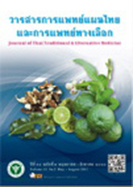Development of Classification and Coding for Thai Traditional Digital Knowledge of Thailand
Main Article Content
Abstract
The purpose of this qualitative study was to analyze and classify traditional knowledge in Thai traditional medical textbooks and formularies, and identify standard codes suitable for Thai traditional medical knowledge system. Strengthening the capability to safeguard Thai traditional medical heritage was the main expected outcome of this study. The study was composed of two stages: First, studying the protection system of traditional medical knowledge in the Republic of India, the Republic of Korea and the Peopleûs Republic
of China. This also included the study of Indian Traditional Knowledge Digital Library (TKDL) and International Patent Classification (IPC). The second stage was the conduct of 20 focus group discussions for experts in Thai traditional medical scriptures to analyze and categorize the contents in 12 Thai medical scriptures so that standard codes could be identified appropriately. The results should that the Thai Traditional Digital Knowledge Classification (TTDKC) conforms to the international classification system. TTDKC comprises five levels of classification, including 2 sections. The 12 classes, 27 sub-classes, 55 groups and 2,176 sub-groups. The standard code in TTDKC is expected to be a tool for management of traditional medical knowledge, the examination of intellectual property rights, and the protection of traditional knowledge from bio-piracy. It is also useful for devising research questions and it should be continually revised inparallel with that for Thai indigenous medicine in the future.


